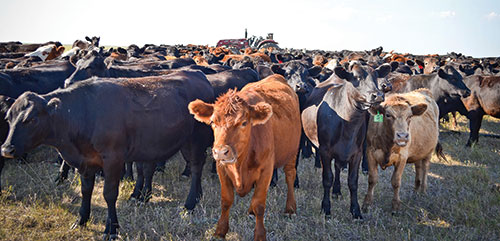Boost stocking rate and profit |
| By Jesse Bussard |
|
|
The author is a freelance writer from Bozeman, Mont., and has her own communications business, Cowpunch Creative.  When it comes to enhancing ranch profit, Johann Zietsman says the most important determinant will always be stocking rate. In mid-August, Zietsman, a cattleman from Zimbabwe, along with Florida grazier Jim Elizondo put on a three-day Profitable Ranching workshop in Billings, Mont. Among the topics discussed were ultra-high stock density (UHSD) grazing. “The goal is to obtain the maximum sustainable profits per acre by attaining the highest stocking rate possible,” says Elizondo. Zietsman concurred, noting for each increase in stocking rate a proportionate gain in profit per acre will be seen. To efficiently utilize the forage resource, Elizondo explains, grazing must be nonselective. This is achieved by using ultra-high stocking densities to maximize utilization. He notes while grazing principles for UHSD grazing methods are universal across environments, application of these principles must be done using an adaptive strategy tailored to each region and climate. On the last day of the workshop, attendees visited Montana rancher Chad Peterson’s operation to get a firsthand view of UHSD grazing in action. Peterson was one of the first graziers in the United States to begin using UHSD grazing on his former Nebraska Sandhills ranch in 2001. According to Peterson, “If you keep your animals bunched up enough and only go over your ranch once a year, you can’t screw it up.” Some pitfalls exist Still, Peterson explains, depending on your location, this grazing style can come with challenges. In his experience, he has found individual animal performance, like application of this grazing style, is largely dictated by environment. While it is possible to grow more grass and improve soil quality, it is impossible to change what the animal performance potential is in a given location. Due to the high-fiber, low-protein forages present in his Nebraska ranch’s environment, Peterson’s “animal performance ceiling” was not very high. In 2014, he moved his operation to Montana where he felt he would have a better chance at obtaining higher animal performance using UHSD grazing methods. Grass quality was the big draw. Peterson started his 2015 grazing season with approximately 1,000 head of stocker heifers and steers. His cattle inventory fluctuates throughout the year as he sells and buys animals. Cattle are kept in one mob and moved at minimum twice a day. Depending on the quality of forage being grazed, however, he has moved cattle as much as six times a day. Determining grazing density Peterson says is a trial-and-error process, “Sometimes you won’t give them a big enough area. Sometimes you’ll give them too much. You’re always adjusting (paddock size) to the last try until you get it right.” Benefits seen from UHSD grazing include an increase in diversity of desirable forage species, while decreasing undesirable ones, as well as more uniform grazing, manure distribution, and trampling of plants. The increased herd effect in turn creates more litter cover, improves water infiltration, and enhances soil health, making the land more resilient to drought and other stresses. Peterson has also noticed less fly and parasite problems in his cattle thanks to the frequent moves of UHSD grazing. Additionally, he is able to run a lower bull-to-cow ratio because bulls do not have to travel far to find females. “In Nebraska, I used one bull to 100 cows and got good breed-ups,” says Peterson. Peterson cautions that producers must be observant. If grazing managers do not pay close enough attention to their animals, stress can occur, leading to reduction in animal performance and, potentially, health problems. Due to the high management skill needed for this style of grazing, Peterson recommends those interested in giving UHSD grazing a try do a trial experiment on productive land. “Get it set up with fencing and water systems so you will be able to do a very good job,” says Peterson. “Do this in a small area so you can experiment, see the results of it, and get some experience before you go all in.” As Peterson pointed out, getting good at UHSD grazing will take time, but when implemented properly this grazing method can yield huge benefits for the land, livestock and producer’s bottom line. More information on ultra-high stock density grazing methods can be found in Zietsman’s book, Man, Cattle, and Veld published in 2014. This article appeared in the November 2015 issue of Hay & Forage Grower on page 16.Not a subscriber? Click to get the print magazine. |
